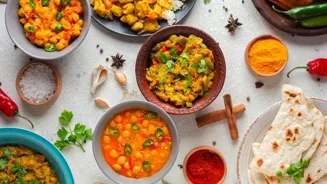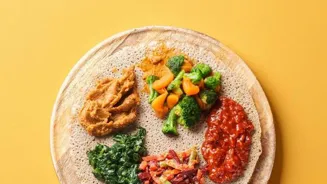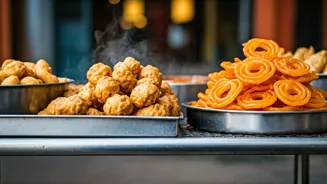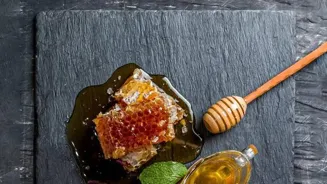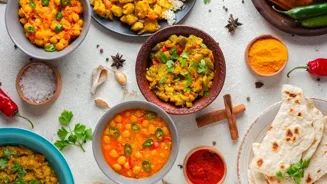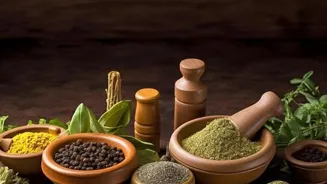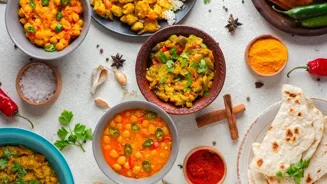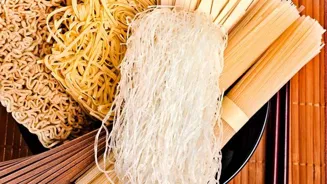10 Unique Cooking Techniques From Around the World You Should Try - Explore global culinary magic & elevate your vegetarian dishes! Read on for flavorful adventures
Namaste, foodies! Are you bored of the
same old dal and roti routine? Want to spice up your culinary adventures? Then ditch the predictable and get ready to explore some seriously cool cooking techniques from across the globe.
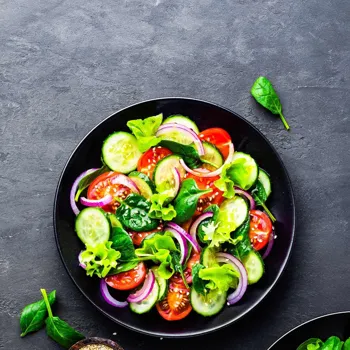
We've scoured the planet for methods that are not only unique but also add a special something to your vegetarian dishes. Prepare to be amazed, inspired, and hungry!
Wood-firing adds rustic charm and depth to vegetarian dishes
Let's kick things off with "Wood-Firing." While tandoors are common in India, the art of wood-firing extends far beyond. Imagine the subtle smokiness it can impart to vegetables. Try grilling paneer or roasting root vegetables over a wood fire.
The slow, even heat and the natural flavors from the wood create a depth that's impossible to replicate with modern ovens. Think rustic, earthy flavors that elevate even the simplest of ingredients. You can even use different types of wood, like fruit woods, for a subtle hint of sweetness.
It's a technique that's as old as time, and one that's still incredibly relevant today, especially for adding a touch of magic to your vegetarian creations. Wood-firing is a technique that has been used for generations.
French sous vide technique for precise cooking of veggies
Next on our culinary journey is "Sous Vide," a French technique that's all about precision. It involves sealing food in airtight bags and immersing them in a water bath held at a constant, precise temperature.
While often used for meat, it's fantastic for cooking delicate vegetables like asparagus or carrots. The even temperature ensures they cook perfectly, retaining their color and nutrients. Imagine perfectly cooked, tender-crisp vegetables every single time!
It might sound complicated, but sous vide machines are now readily available for home use. Give it a try and experience the difference precision cooking can make to your vegetarian palate.
Japanese water bath method for perfect cheesecakes and custards
Now let's swing over to Japan for "Water Bath Cooking," particularly when making Japanese cheesecakes or custards. This gentle method of baking involves placing your baking dish inside a larger pan filled with hot water.
The water bath helps to distribute heat evenly and prevents the cheesecake from cracking or the custard from curdling. The result is a creamy, smooth, and utterly decadent dessert. Its a trick that has been used for a lot of years.
It's a must-try for any baker looking to achieve perfect results with delicate desserts. This is a method in which gentle cooking is used.
Discover the essence of "Comal Cooking" from Mexico; using a flat griddle to enhance flavors
From the streets of Mexico, we find inspiration in "Comal Cooking," a technique using a flat, smooth griddle (the comal) to toast spices, roast vegetables, and warm tortillas. The dry heat of the comal brings out the natural flavors of ingredients, giving them a slightly toasted and smoky taste.
Try toasting aromatic spices like cumin, coriander, and chili flakes on a comal before grinding them for a homemade spice blend. It enhances the flavor and aroma of your dishes. You can also roast bell peppers, onions, and tomatoes on a comal for a flavorful base for salsas or stews.
Comal cooking is simple, versatile, and adds a delicious touch to any Mexican-inspired vegetarian meal.
Fermentation: ancient method for flavor and gut health with probiotics
Moving away from conventional heat, let's look at an unusual method: fermentation. It's an age-old technique used across the world to preserve and enhance food. Fermented foods like kimchi, sauerkraut, and kombucha are packed with probiotics and have a distinctive tangy flavor.
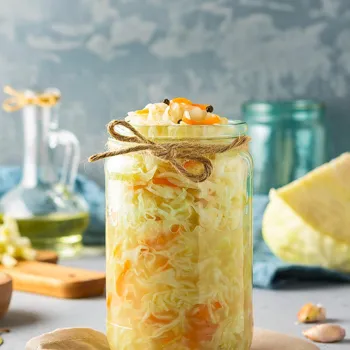
You can now ferment a lot of items at home. Experiment by fermenting vegetables like cabbage, carrots, or radishes to create your own unique pickled delights. Not only will you be adding a burst of flavor to your meals, but you'll also be boosting your gut health!
Fermentation is a natural process that transforms raw ingredients into something truly special.
Explore Korean blanching technique for vibrant, crispy veggies
Finally, let's explore the Korean technique of "Blanching Vegetables With Salt." This involves briefly immersing vegetables in boiling water with salt, then immediately transferring them to ice water to stop the cooking process. Blanching does wonders.
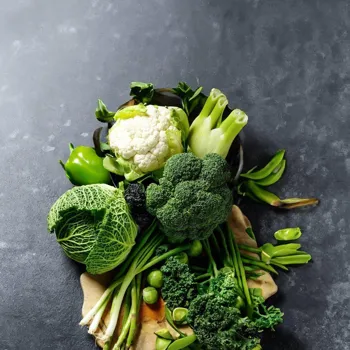
The blanching enhances the vibrant color of the vegetables while helps to keep their texture. This method is especially good for green vegetables. You can use spinach, beans and asparagus as examples. Serve them as a side dish or add them to your favorite salads.
The salt adds a touch of flavor and helps to preserve the color, making them look even more appealing.
AI Generated Content. Glance/InMobi shall have no liability for the content